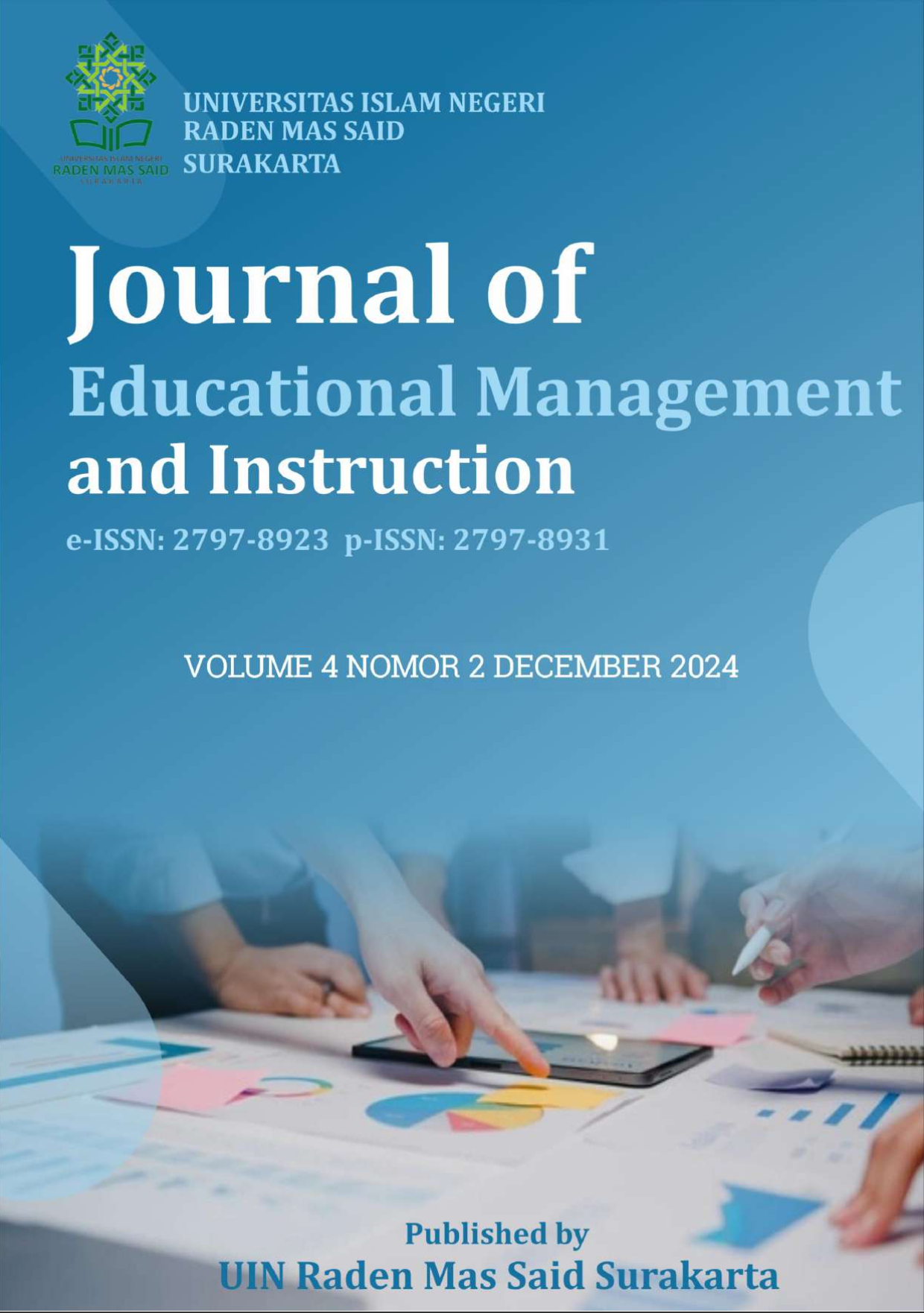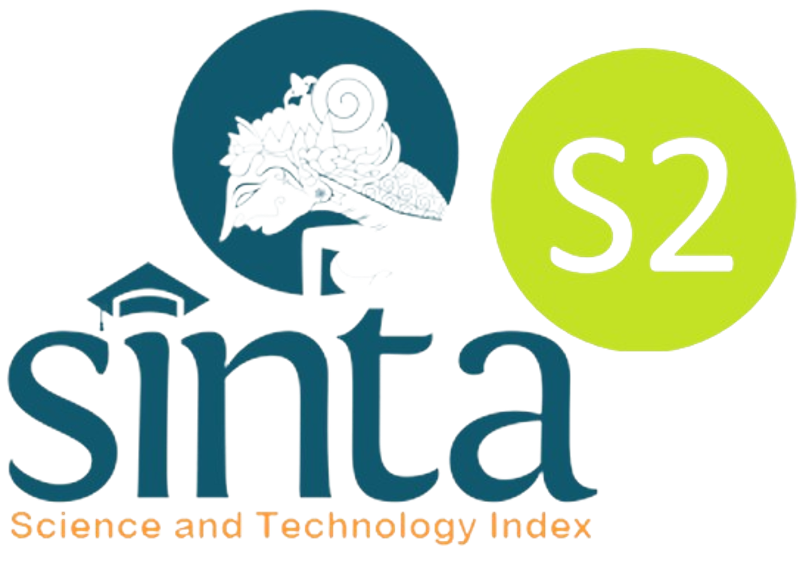Visual expressions of environmental care in primary school students’ drawings
DOI:
https://doi.org/10.22515/jemin.v4i2.9683Keywords:
Drawing, Environmental Care, Primary School Students, Visual ExpressionAbstract
This study analyzed primary school children's drawings from a drawing competition to explore their attitudes towards environmental care. Employing a descriptive qualitative approach, data collection was conducted through observation, interviews, and document analysis. Data analysis was performed using an interactive model analysis technique. The findings reveal that the drawings depict both school and living environments, featuring objects from children's daily activities. The drawings do not fit into a single category, but are a mix of organic, structural, schematic, expressionist, and literary types. The drawing objects were depicted naturally and proportionally using primary colors. The students' visual expressions predominantly used green, red, yellow, and brown, with minimal mixing. The way the drawings are expressed shows the children's personal expressions, but the choice of objects tends to be influenced by adult thinking. The contribution of teachers in developing children's cognitive and skill skills is evident in their drawings, as revealed by interviews with the children regarding the sources of their ideas. Drawing objects reflect children's attitudes, behaviors, and values regarding environmental care, illustrated through scenes such as playing in the schoolyard, family settings, playground objects, school activities, and natural environments. The shapes were naturalistic, simple, overlapping, reclining, and layered with no transparent objects. Their choice of objects and techniques was shaped by their knowledge and experience of nature, with each drawing outlined. Children use drawings to express life events and experiences, so teachers should value these drawings, as research often overlooks children's perspectives in favor of adult viewpoints.
Downloads
References
Abdulhameed, S., & Rashid, T. A. (2022). Child drawing development optimization algorithm based on child’s cognitive development. Arabian Journal for Science and Engineering, 47(2), 1337-1351. https://orcid.org/0000-0002-8661-258X
Addessi, A. R. (2020). A device for children’s instrumental creativity and learning: An overview of the MIROR Platform. Frontiers in Psychology, 11, 516478. https://doi.org/10.3389%2Ffpsyg.2020.516478
Agarwal, M. K., Sehgal, V., & Ogra, A. (2021). Creating a child-friendly environment: An interpretation of children’s drawings from planned neighborhood parks of Lucknow City. Societies, 11(3), 80. https://doi.org/10.3390/soc11030080
Ainsworth, S. E., & Scheiter, K. (2021). Learning by drawing visual representations: Potential, purposes, and practical implications. Current Directions in Psychological Science, 30(1), 61-67. https://doi.org/10.1177/0963721420979582
Ardoin, N. M., & Bowers, A. W. (2020). Early childhood environmental education: A systematic review of the research literature. Educational Research Review, 31, 100353. https://doi.org/10.1016/j.edurev.2020.100353
Becker, I., Rigaud, V. M., & Epstein, A. (2023). Getting to know young children: Alternative assessments in early childhood education. Early Childhood Education Journal, 51(5), 911-923. http://dx.doi.org/10.1007/s10643-022-01353-y
Borawska, I. (2021). Music, visual arts, literature as educational means of holistic influence on a preschool child: Stimulating children's development through art (Polish experience). Zhytomyr Ivan Franko state university journal. Рedagogical sciences, 2(105), 46-60. http://dx.doi.org/10.35433/pedagogy.2(105).2021.46-60
Bosgraaf, L., Spreen, M., Pattiselanno, K., & Hooren, S. V. (2020). Art therapy for psychosocial problems in children and adolescents: A systematic narrative review on art therapeutic means and forms of expression, therapist behavior, and supposed mechanisms of change. Frontiers in psychology, 11, 584685. https://doi.org/10.3389/fpsyg.2020.584685
Brown, A., Spencer, R., McIsaac, J. L., & Howard, V. (2020). Drawing out their stories: A scoping review of participatory visual research methods with newcomer children. International Journal of Qualitative Methods, 19, 1609406920933394. https://doi.org/10.1177/1609406920933394
Çetin, Z., & Güneş, N. (2021). Drawing as a means of self-expression: a case study. Early Child Development and Care, 191(1), 136-147. https://psycnet.apa.org/doi/10.1080/03004430.2019.1608195
Chawla, L. (2020). Childhood nature connection and constructive hope: A review of research on connecting with nature and coping with environmental loss. People and Nature, 2(3), 619-642. http://dx.doi.org/10.1002/pan3.10128
Cohn, N. (2020). Visual narrative comprehension: Universal or not?. Psychonomic Bulletin & Review, 27(2), 266-285. https://doi.org/10.3758/s13423-019-01670-1
Fajrie, N., Kartika, D. D., Utaminingsih, S., & Santoso, D. A. (2024). Natural material-based art learning model increases aesthetic experiences in early childhood. Jurnal Pendidikan Anak Usia Dini Undiksha, 12(1). https://doi.org/10.23887/paud.v12i1.74612
Fan, J. E., Bainbridge, W. A., Chamberlain, R., & Wammes, J. D. (2023). Drawing as a versatile cognitive tool. Nature Reviews Psychology, 2(9), 556-568. https://doi.org/10.1038/s44159-023-00212-w
Gibson, R., & Ewing, R. (2020). Transforming the curriculum through the arts. Springer International Publishing.
Hall, E. (2020). My rocket: Young children’s identity construction through drawing. International Journal of Education & the Arts, 21(28). http://doi.org/10.26209/ijea21n28
Harris, P. L. (2021). Early constraints on the imagination: The realism of young children. Child Development, 92(2), 466-483. http://dx.doi.org/10.5281/zenodo.8052835
Herranen, D. (2020). How to enhance children's creativity through storytelling: Handbook for early childhood education practitioners. [Bachelor Thesis, Metropolia University of Applied Sciences]. https://www.theseus.fi/bitstream/handle/10024/349011/Dominika%20Herranen%20Thesis.pdf?sequence=2
Klöckner, C. A., & Sommer, L. K. (2021). Visual art inspired by climate change—An analysis of audience reactions to 37 artworks presented during 21st UN climate summit in Paris. Plos one, 16(2), e0247331. https://doi.org/10.1371/journal.pone.0247331
Lengieza, M. L., Aviste, R., & Richardson, M. (2023). The human–nature relationship as a tangible target for pro-environmental behaviour—Guidance from interpersonal relationships. Sustainability, 15(16), 12175. https://doi.org/10.3390/su151612175
Leshem, R., Heltai, S. H., & Mashal, N. (2023). Personality traits and environment: The effects of observing visual art on verbal creativity. Progress in Brain Research, 277, 85-108. https://doi.org/10.1016/bs.pbr.2022.12.006
Li, D., Zhai, Y., Chang, P. J., Merrill, J., Browning, M. H., & Sullivan, W. C. (2022). Nature deficit and senses: Relationships among childhood nature exposure and adulthood sensory profiles, creativity, and nature relatedness. Landscape and Urban Planning, 226, 104489. https://doi.org/10.1016/j.landurbplan.2022.104489
Lionetti, F., & Pluess, M. (2024). The role of environmental sensitivity in the experience and processing of emotions: implications for well-being. Philosophical Transactions of the Royal Society B, 379(1908), 20230244. https://doi.org/10.1098/rstb.2023.0244
Loureiro, K. S., Grecu, A., de Moll, F., & Hadjar, A. (2020). Analyzing drawings to explore children’s concepts of an ideal school: Implications for the improvement of children’s well-being at school. Child Indicators Research, 13(4), 1387-1411. https://doi.org/10.1007/s12187-019-09705-8
Lowenfeld. V. (1947). Creative and mental growth. Macmillan.
Lowenfeld, Viktor & Lambert W. Brittain. (1982). Creative and Mental Growth. The MacMillan Publishing Company.
Luo, N., Ibrahim, R., & Abidin, S. Z. (2022). Transformation of children’s paintings into public art to improve public spaces and enhance people’s happiness. International journal of environmental research and public health, 19(24), 16780. https://doi.org/10.3390/ijerph192416780
Magsamen, S., & Ross, I. (2023). Your brain on art: How the arts transform us. Random House.
Matloob Haghanikar, T., & Leigh, S. R. (2022). Assessing Children’s Drawings in Response to COVID-19. Journal of Research in Childhood Education, 36(4), 697-714. http://dx.doi.org/10.1080/02568543.2022.2042431
Moula, Z., Walshe, N., & Lee, E. (2021). Making nature explicit in children’s drawings of wellbeing and happy spaces. Child Indicators Research, 14(4), 1653-1675. https://doi.org/10.1007/s12187-021-09811-6
Muhr, M. M. (2020). Beyond words–the potential of arts-based research on human-nature connectedness. Ecosystems and People, 16(1), 249-257. https://doi.org/10.1080/26395916.2020.1811379
Park, J., Tang, K. S., & Chang, J. (2021). Plan‐draw‐evaluate (PDE) pattern in students' collaborative drawing: Interaction between visual and verbal modes of representation. Science Education, 105(5), 1013-1045. https://doi.org/10.1002/sce.21668
Ramli, M. F., & Musa, R. (2020). An exploration of thematic sketch through visual arts activities towards the preschool children. Southeast Asia Early Childhood Journal, 9(2), 132-143. https://files.eric.ed.gov/fulltext/EJ1288453.pdf
Robb, A. (2021). Children talking about their experiences of visual art in and out of the classroom: A systematic literature review. International Journal of Student Voice, 6(2). https://ijsv.psu.edu/files/2023/05/Children-talking-about-their-experiences-of-visual-art-in-and-out-of-the-classroom-a-systematic-literature-review-1.pdf
Schroeder, H. W. (2021). Ecology of the heart: Understanding how people experience natural environments. In Natural Resource Management (pp. 13-27). Routledge.
Strauss, M. (2021). Understanding children’s drawings: Tracing the path of incarnation. Rudolf Steiner Press.
Stroumbos, N. (2022). I, you and we: Expressive arts therapy interventions and childhood identity development: Development of a Method. [Thesis, Lesley University]. Expressive Therapies Capstone Theses. 632. https://digitalcommons.lesley.edu/cgi/viewcontent.cgi?article=1639&context=expressive_theses
Trihastutie, N. (2023). Interpreting Children’S Appreciation of Children’S Literature in the Visual Literacy Era. Linguistics and Literature Journal, 4(1), 14-20.
Winner, E., & Drake, J. E. (2022). The child as visual artist. Cambridge University Press.
Ylirisku, H. (2021). Reorienting environmental art education. Aalto University.
Zamelyuk, M. I., & Mahdysiuk, L. I. (2021). The mastery of art therapy in working with preschool children. Scientific Bulletin of Mukachevo State University. Series “Pedagogy and Psychology”, 7(2). https://doi.org/10.52534/msu-pp.7(2).2021.79-85
Zhang, C., Yao, C., Wu, J., Lin, W., Liu, L., Yan, G., & Ying, F. (2022, April). StoryDrawer: A child–AI collaborative drawing system to support children's creative visual storytelling. In Proceedings of the 2022 CHI conference on human factors in computing systems (pp. 1-15). https://doi.org/10.1145/3491102.3501914
Downloads
Submitted
Accepted
Published
How to Cite
Issue
Section
License
Copyright (c) 2024 Zariul Antosa, Jupriani Jupriani

This work is licensed under a Creative Commons Attribution-NonCommercial 4.0 International License.
Copyright
Copyright aims to protect the specific way the article has been written to describe an experiment and the results. Journal of Educational Management and Instruction is committed to its authors to protect and defend their work and their reputation and takes allegations of infringement, plagiarism, ethical disputes, and fraud very seriously. Automotive Experiences is published under the terms of the Attribution-NonCommercial 4.0 International (CC BY-NC 4.0). Authors retain copyright and grant the journal right of first publication (online and print) with the work simultaneously. We use the restrictive license (non-commercial) as follows:
BY (attribution): Users are allowed to share, distribute and redistribute the published article in any medium or format, with an identification of the authors and its initial publication in this journal. Authors are encouraged to post and distribute their articles immediately after publication (e.g., institutional or public repositories, personal websites). Authors are allowed to enter into additional contractual arrangements for the non-exclusive distribution of the published and an acknowledgment of its initial publication in this journal.
NC (non-commercial): Users are not allowed to use the article commercially without the permission of the authors. Authors agree explicitly that the published article is indexed worldwide in databases, repositories and indexation services, even if these services operate on a commercial basis. Authors grant Journal of Educational Management and Instruction explicit the right to include the published articles in databases, repositories and indexation services.
License
License to Publish
The non-commercial use of the article will be governed by the Attribution-NonCommercial 4.0 International (CC BY-NC 4.0). The author hereby grants Journal of Educational Management and Instruction an exclusive publishing and distribution license in the manuscript include tables, illustrations or other material submitted for publication as part of the manuscript (the “Articleâ€) in print, electronic and all other media (whether now known or later developed), in any form, in all languages, throughout the world, for the full term of copyright, and the right to license others to do the same, effective when the article is accepted for publication. This license includes the right to enforce the rights granted hereunder against third parties.
Author's Warranties
The author warrants that the article is original, written by stated author/s, has not been published before, contains no unlawful statements, does not infringe the rights of others, is subject to copyright that is vested exclusively in the author and free of any third party rights, and that any necessary written permissions to quote from other sources have been obtained by the author(s).
User Rights
Under the Creative Commons Attribution-Non Commercial 4.0 International (CC BY-NC 4.0) license, the author(s) and users are free to share (copy and redistribute the material in any medium or format) and adapt (remix, transform, and build upon the material). Users must give appropriate credit, provide a link to the license, and indicate if changes were made.
Rights of Authors
Authors retain the following rights:
- Copyright, and other proprietary rights relating to the article, such as patent rights,
- The right to use the substance of the article in future own works, including lectures and books,
- The right to reproduce the article for own purposes, provided the copies are not offered for sale, and
- The right to self-archive the article.
Co-authorship
If the article was prepared jointly with other authors, the signatory of this form warrants that he/she has been authorized by all co-authors to sign this agreement on their behalf, and agrees to inform his/her co-authors of the terms of this agreement.

























